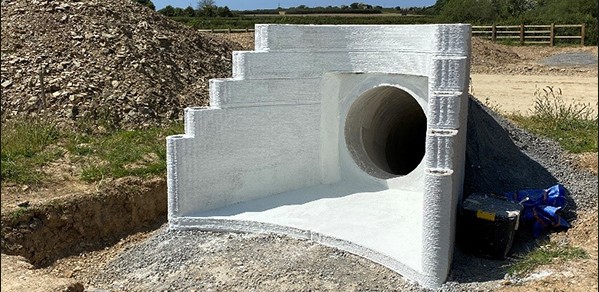Cambridge researchers, working with industry, have helped develop the first 3D-printed piece of concrete infrastructure to be used on a UK dual carriageway.
The structure, a retaining wall, has been placed on the A30 in Cornwall. It is fitted with Cambridge-developed sensors that provide real-time information on temperature, strain and pressure. This “digital twin” of the wall allows for early failure detection and repair.
Using 3D printing technology, the team designed a curved, supporting hollow wall, without conventional formwork or steel reinforcement. The wall gains its stability from its special geometry.
This wall, which is approximately two meters high and three and a half meters wide, was printed using a robotic concrete printer. This method saves significantly on costs, materials and carbon emissions.
The team, led by Prof. Abir Al-Tabbaa, has developed “smart” self-healing concretes and novel sensor technologies. Temperature measurements were taken during the printing process to detect possible thermal anomalies.
“Since you need an extremely fast-setting cement for 3D printing, it also generates an enormous amount of heat,” said Al-Tabbaa. “We embedded our sensors in the wall to measure temperature during construction, and now we’re getting data from them while the wall is on site.”
In addition to temperature, the sensors measure moisture, pressure, strain, electrical resistance and electrochemical potential. LiDAR technology scanned the wall while it was in compression, creating a digital twin.
“Making the wall digital means it can speak for itself,” said Al-Tabbaa. “And we can use our sensors to understand these 3D printed structures better and accelerate their acceptance in industry.”
The team has developed a special sensor that monitors changes over time and detects potential damage. These smart sensors can show how 3D-printed concrete is curing while also monitoring the condition of the host building.
“This project will serve as a living laboratory, generating valuable data over its lifespan,” said Al-Tabbaa. “The sensor data and ‘digital twin’ will help infrastructure professionals better understand how 3D printing can be used and tailored to print larger and more complex cement-based materials for the strategic road network.”
Team members included Dr. Sripriya Rengaraju, Dr. Christos Vlachakis, Dr. Yen-Fang Su, Dr. Damian Palin, Dr. Hussam Taha, Dr. Richard Anvo and Dr. Lilia Potseluyko from Cambridge, as well as Costain’s Head of Materials, Bhavika Ramrakhyani, a part-time PhD student in Engineering, and Ben Harries, Architectural Innovation Lead at Versarien, who is also starting a part-time PhD in Engineering in October.
The research is part of the ‘Resilient Materials for Life’ program and the ‘Digital Roads of the Future’ initiative. It is supported by the EPSRC, part of UKRI, and the European Union.
Subscribe to our Newsletter
3DPresso is a weekly newsletter that links to the most exciting global stories from the 3D printing and additive manufacturing industry.






















